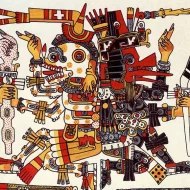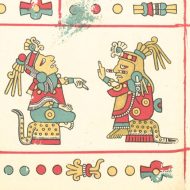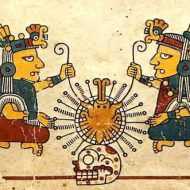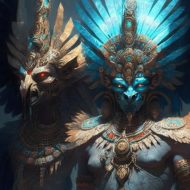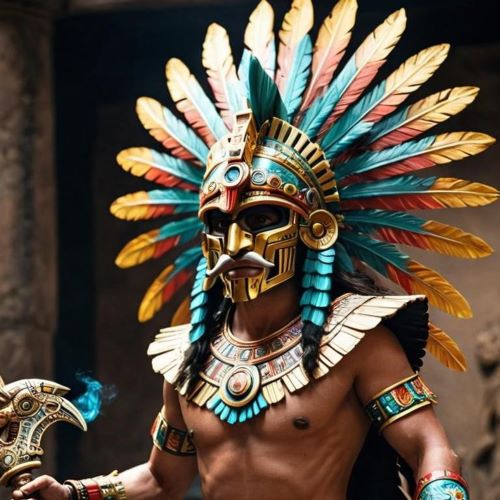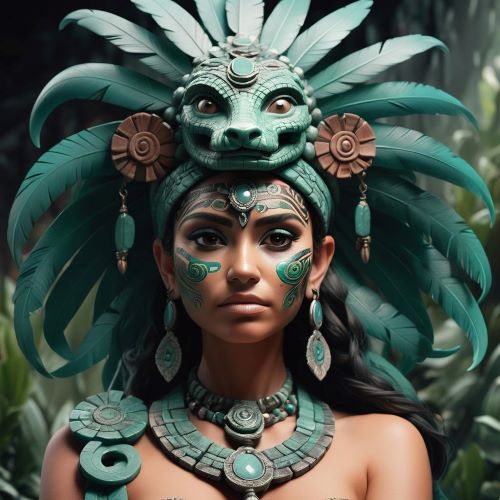Ometeotl : The Dual God
Listen
At a glance
| Description | |
|---|---|
| Origin | Aztec Mythology |
| Classification | Gods |
| Family Members | Xipec Totec, Tezcatlipoca, Huitzilopochtli, Quetzalcoatl (Sons) |
| Region | Mexico |
| Associated With | Creation |
Ometeotl
Introduction
The Ometecuhtli-Omecihuatl duo was regarded as a binary god in Aztec mythology. The Aztecs believed that before Ometeotl created himself, the universe was not real. Ometecuhtli was an Aztec deity who represented the aspect of the Aztec tradition that deals with the dual nature of life and death. He resided in Omeyocan, which is regarded as the 13th and highest heaven in the Aztec pantheon.
The Aztec universe had opposing elements, such as the sexes, light and dark, chaos, and motion and stillness. The only Aztec god who didn’t have a temple was Ometecuhtli. Since he was remote, they assumed he wouldn’t interact with them, but he was always present in their rituals.
The Ometéotl complex is composed of various deities, such as Ometecuhtli, who are depicted with fertility symbols and adorned with corn ears. It is believed that he was responsible for the souls of infants from the Omeyocan region to help prepare for the arrival of humans on Earth. Despite the importance of the Ometéostl to the Aztec pantheon, other lesser deities were also regarded as autonomous and independent.
Physical Traits
Ometeotl is considered to emphasize duality but there is no consensus on the physicality of the god as there are no temples or pyramids dedicated to the gods. They are open depicted as almost identical either facing each other or with their backs to each other. The Aztecs believed that the universe was made up of polar opposite elements, such as the dark and light, as well as chaos and order. They regarded Ometeotl as the first god who actually created the universe after creating himself.
Family
The Ometeotl-Ometecuhtli duo had no known parents. Ometeotl had four sons, and these would become prominent figures in the Aztec pantheon. Some of the other deities who are known to be associated with the Ometéotl complex include Xipe Totec, who is the god of agriculture, Huitzilopochtli, Quetzalcoatl and Tezcatlipoca, who is the god of the night sky.
Other names
The term “Ometeotl” was used in Nahuatl to refer to a dual god or “Lord of Duality.” Since the name didn’t appear in official documents, some people questioned if Ometeotl really existed. The Aztec gods that were associated with the Ometeotl complex were Omecihuatl and Ometecuhtl.
In Aztec sources, the pair were referred to as Tonacacihuatl and Tonacatecuhtli. The former’s name was similar to that of her husband, though the suffix “cihuatl” was translated to “Lady of.” Tonacatecuhtli was often referred to as the “lord of abundance,” “lord of food,” “lord of existence,” or “lord of susstenance.” These titles imply that Tonacacihuatl was the founder of the Aztec pantheon.
Powers and Abilities
The Ometeotl was unique among Aztec gods as they didn’t have temples. After they had children, their minimal role in Aztec mythology didn’t change. Even though their offspring were regarded as some of the most significant deities in the Aztec pantheon, Tonacatecuhtli and Tonacacihuatl’s lesser gods didn’t take on the mantle of Ometeotl.
While the Aztecs considered Ometeotl to be highly significant due to his role in the universe’s creation, they also believed that he was beyond the influence of humans. Therefore, they did not build a temple or offer sacrifices to him.
Modern Day Influence
The mythology behind this Aztec god is highly debated even today with two distinct schools of though existing claiming either the existence or the misrepresentation of other traditional gods.
Related Images
Frequently Asked Questions
What is lorem Ipsum?
I am text block. Click edit button to change this text. Lorem ipsum dolor sit amet, consectetur adipiscing elit. Ut elit tellus, luctus nec ullamcorper mattis, pulvinar dapibus leo.
What is lorem Ipsum?
I am text block. Click edit button to change this text. Lorem ipsum dolor sit amet, consectetur adipiscing elit. Ut elit tellus, luctus nec ullamcorper mattis, pulvinar dapibus leo.
What is lorem Ipsum?
I am text block. Click edit button to change this text. Lorem ipsum dolor sit amet, consectetur adipiscing elit. Ut elit tellus, luctus nec ullamcorper mattis, pulvinar dapibus leo.
What is lorem Ipsum?
I am text block. Click edit button to change this text. Lorem ipsum dolor sit amet, consectetur adipiscing elit. Ut elit tellus, luctus nec ullamcorper mattis, pulvinar dapibus leo.
What is lorem Ipsum?
I am text block. Click edit button to change this text. Lorem ipsum dolor sit amet, consectetur adipiscing elit. Ut elit tellus, luctus nec ullamcorper mattis, pulvinar dapibus leo.

